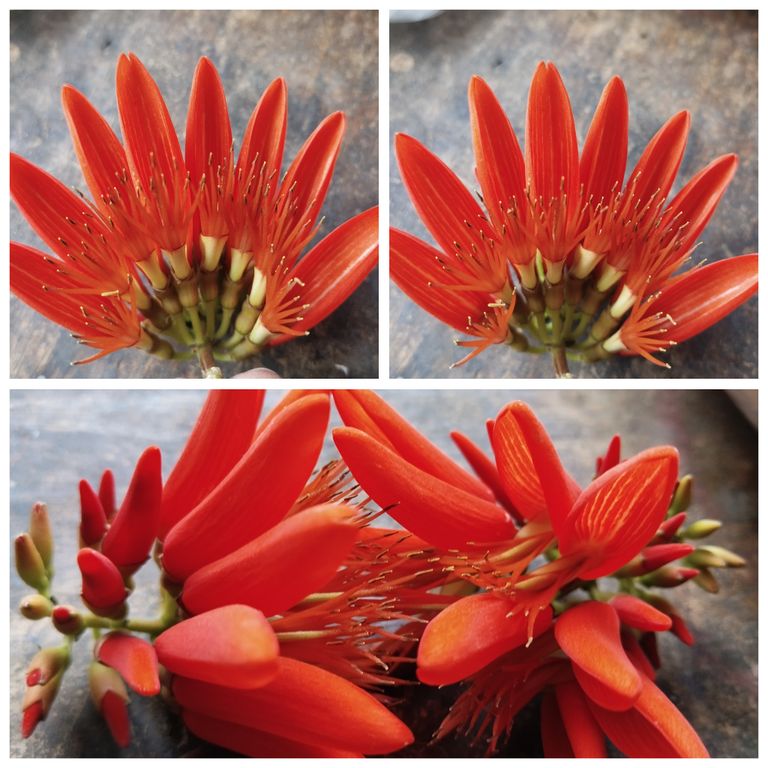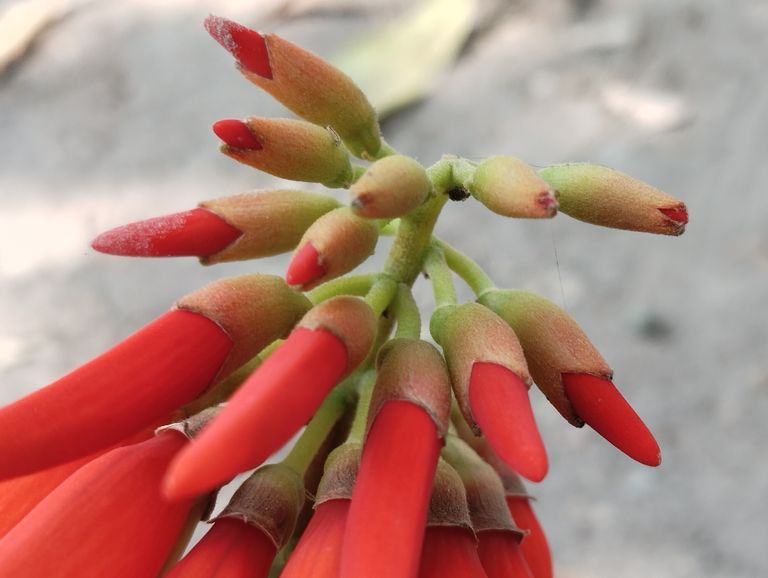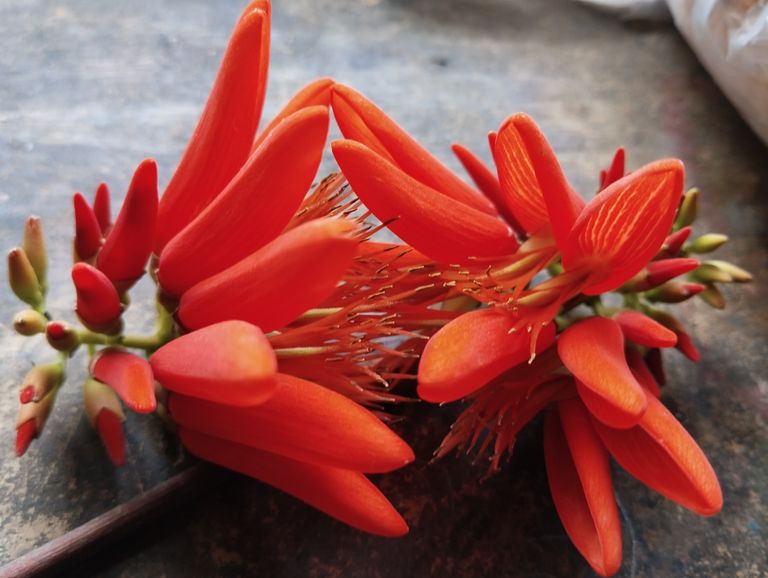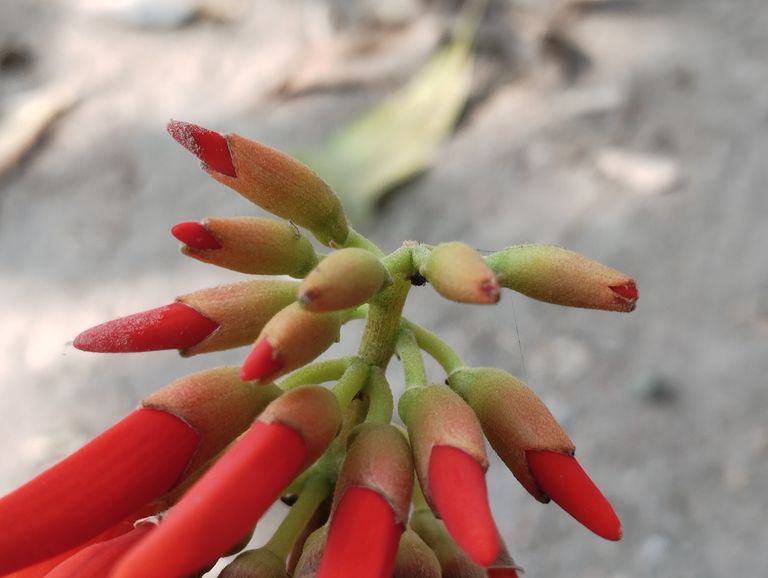
The Beauty of the Red Cotton Flower Bombax ceiba in Photography.
Nature has blessed us with countless mesmerizing flowers, each with its own unique charm. One such strikingly beautiful bloom is the Red Cotton Flower (Bombax ceiba), known as "Kata Mandar" in Bengali. This vibrant red flower, with its bold and exotic appearance, has been a subject of admiration for nature lovers, poets, and photographers alike.
In this blog, we will explore the art of photographing the Kata Mandar flower, its significance, and how to capture its essence through your lens.
Understanding the Red Cotton Flower
Scientific and Cultural Significance
The Bombax ceiba, commonly known as the Silk Cotton Tree or Red Cotton Tree, belongs to the Malvaceae family. Native to tropical and subtropical regions, this deciduous tree is famous for its large, cup-shaped red flowers that bloom in early spring before the leaves appear.
In Bengali literature and culture, the Kata Mandar holds a special place. It is often associated with the arrival of spring, symbolizing new beginnings and natural beauty. The bright red petals and prominent stamens make it a favorite among photographers and artists.
Why Photograph the Red Cotton Flower?
- Bold and Vibrant Colors
The deep red or scarlet petals create a stunning contrast against the blue sky, making it an ideal subject for vibrant photography.
- Unique Shape and Texture
The thick, fleshy petals and prominent dark stamens give the flower a dramatic and exotic look, perfect for macro photography.
- Seasonal Beauty
Since the tree blooms in early spring (February to April), it offers a rare opportunity for seasonal photography.
- Wildlife Attraction
These flowers attract birds, butterflies, and bees, making it a great subject for capturing nature’s interactions.
Best Techniques for Photographing the Kata Mandar Flower
- Choosing the Right Camera and Lens
For the best shots, use:
DSLR or Mirrorless Camera – Provides high-resolution images with better depth and detail.
Macro Lens (50mm to 100mm) – Ideal for close-up shots, capturing the intricate details of the petals and stamens.
Telephoto Lens (200mm to 400mm) – Useful for capturing birds feeding on the nectar.
- Optimal Camera Settings
To highlight the beauty of the flower:
Aperture: Use f/2.8 to f/5.6 for a blurred background and a sharp flower.
Shutter Speed: Keep it at 1/500 sec or faster to avoid motion blur, especially if capturing birds or bees.
ISO: Set between 100-400 to maintain clarity without excessive noise.
- Lighting and Timing
Golden Hour: The best time to shoot is early morning (6 AM – 8 AM) or late afternoon (4 PM – 6 PM). The soft sunlight enhances the red hues and adds depth.
Avoid Harsh Noon Light: It may cause overexposed images with harsh shadows.
- Composition and Angles
Close-up Macro Shots: Focus on the intricate details of the petals and stamens.
Low-Angle Shots: Capture the flower against the sky for a dramatic effect.
Bird and Insect Photography: Wait patiently to capture birds or bees feeding on nectar.
- Background and Depth of Field
Use a shallow depth of field (f/2.8 - f/4) to blur the background and highlight the flower.
Look for contrasting backgrounds like a blue sky or dark green leaves to enhance the color vibrancy.
Post-Processing Tips
- Adjusting Colors and Contrast
Increase the red saturation slightly to make the flower pop.
Enhance the contrast and sharpness for a more vivid look.
- Cropping and Framing
Crop unnecessary distractions and focus on the main subject.
Follow the rule of thirds for balanced composition.
- Noise Reduction
If the image was shot in low light, use noise reduction tools in Adobe Lightroom or Photoshop.
Inspiration: Famous Photographers and Artists
Several nature photographers have captured the essence of the Kata Mandar flower beautifully. You can explore the works of:
Rathika Ramasamy – Known for wildlife and floral photography.
Sudhir Shivaram – Expert in capturing nature’s beauty.
Final Thoughts
Photographing the Kata Mandar (Bombax ceiba) flower is a rewarding experience for any photography enthusiast. Its bold red color, seasonal charm, and interaction with wildlife make it a perfect subject. With the right camera settings, composition techniques, and patience, you can create breathtaking images that showcase the flower’s beauty.
So, grab your camera and head outdoors during the blooming season to capture the stunning Red Cotton Flower in all its glory!
Have you photographed the Kata Mandar flower before? Share your best shots and experiences in the comments.


Medicinal Benefits of the Red Cotton Tree (Bombax ceiba)
The Red Cotton Tree (Bombax ceiba), commonly known as "Kata Mandar" in Bengali, is a majestic tree found in tropical and subtropical regions. It is widely recognized for its stunning red flowers, which bloom in early spring. Apart from its ornamental beauty, this tree holds significant medicinal value in Ayurveda, Unani, and traditional folk medicine.
In this blog, we will explore the medicinal benefits of different parts of the Kata Mandar tree, focusing on its flowers, bark, roots, leaves, and gum.
- Medicinal Properties of the Red Cotton Tree
Various parts of the Kata Mandar tree possess medicinal properties, including:
Anti-inflammatory – Reduces swelling and inflammation.
Astringent – Helps in wound healing and tissue contraction.
Hemostatic – Stops bleeding.
Diuretic – Increases urine output and detoxifies the body.
Aphrodisiac – Enhances reproductive health.
Immunomodulatory – Boosts the immune system.
Anti-diarrheal – Treats digestive disorders.
These properties make the Red Cotton Tree a valuable natural remedy for various ailments.
- Health Benefits of Different Parts of Kata Mandar
A. Flowers
The vibrant red flowers of the Bombax ceiba have several medicinal uses:
- Blood Purification – The dried flowers are used in herbal decoctions to purify the blood and remove toxins.
- Diarrhea and Dysentery – The dried flowers are powdered and consumed with water to treat diarrhea.
- Skin Health – Paste made from fresh flowers helps soothe burns, rashes, and wounds.
- Liver Detoxification – Tea made from the flowers supports liver health and aids detoxification.
B. Bark
The bark of the Red Cotton Tree has strong medicinal properties:
- Wound Healing – The bark is ground into a paste and applied to wounds and ulcers to promote healing.
- Diabetes Control – A decoction of the bark is used to regulate blood sugar levels.
- Anti-inflammatory – It is beneficial in treating joint pain and arthritis.
- Fever Reduction – Bark extract helps in reducing fever and fighting infections.
C. Roots
The roots of Kata Mandar have potent therapeutic effects:
- Urinary Disorders – A root decoction is used to treat kidney and bladder infections.
- Impotence and Infertility – The roots are considered an aphrodisiac and are used in traditional medicines to improve male fertility.
- Digestive Health – Root extract aids digestion and relieves constipation.
D. Leaves
The leaves of the Bombax ceiba are also medicinally important:
- Anti-inflammatory Effects – Crushed leaves are applied to swollen areas to reduce inflammation.
- Wound Healing – Leaf juice is applied to wounds for faster healing.
- Respiratory Health – Leaf extract helps relieve cough and asthma symptoms.
E. Gum (Mocharas)
The gum exuded from the Bombax ceiba tree, known as "Mocharas," is highly valued in traditional medicine:
- Cooling Agent – It is used to reduce body heat, especially in summer.
- Sexual Health – Mocharas is often used as an aphrodisiac in Ayurvedic medicine.
- Diarrhea and Dysentery – Mixed with water, it helps treat stomach disorders.
- Traditional Uses in Ayurvedic and Unani Medicine
In Ayurveda, the Red Cotton Tree is considered "Sheetala" (cooling) and is used to balance Pitta and Kapha doshas.
In Unani medicine, it is widely used for treating bleeding disorders, sexual weakness, and urinary problems.
- How to Use Kata Mandar for Health Benefits
A. Flower Tea for Liver Detox
Take 5-6 dried flowers of Bombax ceiba.
Boil them in 2 cups of water for 10 minutes.
Strain and drink once daily.
B. Bark Paste for Wounds
Take fresh bark and grind it into a paste.
Apply directly to wounds, ulcers, or burns for quick healing.
C. Root Decoction for Urinary Health
Boil 1 tablespoon of crushed roots in 2 cups of water.
Reduce to half and drink twice daily.
D. Mocharas Powder for Stomach Health
Mix ½ teaspoon of Mocharas powder with water.
Consume before meals to treat diarrhea.
- Side Effects and Precautions
Though Bombax ceiba is generally safe, excessive consumption may cause:
Gastric irritation if taken in high doses.
Allergic reactions in sensitive individuals.
Lower blood sugar levels, so diabetics should monitor their glucose levels.
Pregnant and breastfeeding women should consult a doctor before using it medicinally.
- Conclusion
The Red Cotton Tree (Kata Mandar) is a powerhouse of medicinal benefits, offering natural remedies for various health conditions. Whether used for wound healing, digestive disorders, or reproductive health, this tree provides a sustainable and effective solution in traditional medicine.
By incorporating Bombax ceiba into herbal treatments, one can harness its healing properties and improve overall well-being naturally.
Would you like to learn more about how to prepare home remedies using Kata Mandar? Let us know in the comments.

How to Plant a Cut Manda Tree Sapling
Manda trees, also known for their vibrant flowers and medicinal benefits, can be propagated from cuttings. If you have a cut Manda tree and want to plant its sapling, proper care and techniques are necessary to ensure healthy growth. In this guide, we’ll cover everything from selecting the right sapling to post-planting care.
- Choosing the Right Manda Tree Sapling
Before planting, it is crucial to choose a healthy sapling. If you’re using a cutting from a mature Manda tree, ensure:
The cutting is at least 6–12 inches long and has a few nodes.
It comes from a disease-free, healthy tree.
The base of the cutting is slightly hardened, not too soft or too woody.
If possible, select a cutting that already has small roots developing.
You can also buy Manda tree saplings from nurseries if you don’t want to propagate from a cutting.
- Preparing the Soil
Manda trees thrive in well-draining, fertile soil. The ideal soil mix should include:
Loamy or sandy soil to prevent waterlogging.
Organic compost or aged manure to enhance nutrient content.
A slightly acidic to neutral pH (6.0–7.5) for optimal growth.
Before planting, loosen the soil up to 12 inches deep and remove any weeds or debris.
- Planting the Manda Tree Sapling
Follow these steps to plant the sapling successfully:
Step 1: Root Treatment (For Cuttings)
If you’re using a cutting instead of a rooted sapling, dip the cut end into rooting hormone powder to stimulate faster root growth.
Step 2: Digging the Hole
Dig a hole twice the size of the root ball or cutting (about 6–8 inches deep).
If planting in a pot, choose one with drainage holes and at least 12 inches in diameter.
Step 3: Placing the Sapling
Position the sapling in the hole so that the roots or cutting base are well-covered.
Gently press the soil around the sapling to eliminate air pockets.
Step 4: Watering
Water immediately after planting to moisten the soil.
Avoid overwatering, as Manda trees don’t tolerate waterlogged conditions.
- Post-Planting Care
Proper care after planting is essential to ensure the sapling’s survival and growth.
Sunlight Requirements
Manda trees need full sunlight (at least 6–8 hours daily). If growing in a pot, place it in a bright, sunny spot.
Watering Schedule
Water 2–3 times a week during dry seasons.
Reduce watering during the monsoon or winter to prevent root rot.
Fertilization
Apply a balanced organic fertilizer once a month.
Use bone meal or phosphate-rich fertilizer to promote root development.
Mulching
Adding a layer of dry leaves or straw around the base helps retain moisture and prevents weed growth.
Common Problems and Solutions
Yellowing Leaves
Cause: Overwatering or poor drainage.
Solution: Reduce watering and improve soil drainage.
- Slow Growth
Cause: Nutrient deficiency.
Solution: Add organic compost or a slow-release fertilizer.
- Pest Attacks
Common Pests: Aphids, mealybugs, and caterpillars.
Solution: Use neem oil spray or organic pesticides.
- Transplanting and Long-Term Care
Once your Manda sapling grows 12–18 inches tall, you can transplant it to a larger space if needed.
Best time for transplanting: Early morning or late afternoon.
Keep the root ball intact to avoid transplant shock.
Continue fertilizing every 3–4 months for strong growth.
Final Thoughts
Planting a cut Manda tree sapling is a rewarding process that requires patience and care. By ensuring the right soil, watering, and sunlight conditions, your sapling can grow into a healthy, flowering tree. Whether you're planting for shade, aesthetics, or its medicinal benefits, a well-maintained Manda tree can thrive for years. Would you like more tips on Manda tree care or propagation? Let me know.

How to Plant a Cut Manda Tree Sapling
Manda trees, also known for their vibrant flowers and medicinal benefits, can be propagated from cuttings. If you have a cut Manda tree and want to plant its sapling, proper care and techniques are necessary to ensure healthy growth. In this guide, we’ll cover everything from selecting the right sapling to post-planting care.
- Choosing the Right Manda Tree Sapling
Before planting, it is crucial to choose a healthy sapling. If you’re using a cutting from a mature Manda tree, ensure:
The cutting is at least 6–12 inches long and has a few nodes.
It comes from a disease-free, healthy tree.
The base of the cutting is slightly hardened, not too soft or too woody.
If possible, select a cutting that already has small roots developing.
You can also buy Manda tree saplings from nurseries if you don’t want to propagate from a cutting.
- Preparing the Soil
Manda trees thrive in well-draining, fertile soil. The ideal soil mix should include:
Loamy or sandy soil to prevent waterlogging.
Organic compost or aged manure to enhance nutrient content.
A slightly acidic to neutral pH (6.0–7.5) for optimal growth.
Before planting, loosen the soil up to 12 inches deep and remove any weeds or debris.
- Planting the Manda Tree Sapling
Follow these steps to plant the sapling successfully:
Step 1: Root Treatment (For Cuttings)
If you’re using a cutting instead of a rooted sapling, dip the cut end into rooting hormone powder to stimulate faster root growth.
Step 2: Digging the Hole
Dig a hole twice the size of the root ball or cutting (about 6–8 inches deep).
If planting in a pot, choose one with drainage holes and at least 12 inches in diameter.
Step 3: Placing the Sapling
Position the sapling in the hole so that the roots or cutting base are well-covered.
Gently press the soil around the sapling to eliminate air pockets.
Step 4: Watering
Water immediately after planting to moisten the soil.
Avoid overwatering, as Manda trees don’t tolerate waterlogged conditions.
- Post-Planting Care
Proper care after planting is essential to ensure the sapling’s survival and growth.
Sunlight Requirements
Manda trees need full sunlight (at least 6–8 hours daily). If growing in a pot, place it in a bright, sunny spot.
Watering Schedule
Water 2–3 times a week during dry seasons.
Reduce watering during the monsoon or winter to prevent root rot.
Fertilization
Apply a balanced organic fertilizer once a month.
Use bone meal or phosphate-rich fertilizer to promote root development.
Mulching
Adding a layer of dry leaves or straw around the base helps retain moisture and prevents weed growth.
Common Problems and Solutions
Yellowing Leaves
Cause: Overwatering or poor drainage.
Solution: Reduce watering and improve soil drainage.
- Slow Growth
Cause: Nutrient deficiency.
Solution: Add organic compost or a slow-release fertilizer.
- Pest Attacks
Common Pests: Aphids, mealybugs, and caterpillars.
Solution: Use neem oil spray or organic pesticides.
- Transplanting and Long-Term Care
Once your Manda sapling grows 12–18 inches tall, you can transplant it to a larger space if needed.
Best time for transplanting: Early morning or late afternoon.
Keep the root ball intact to avoid transplant shock.
Continue fertilizing every 3–4 months for strong growth.